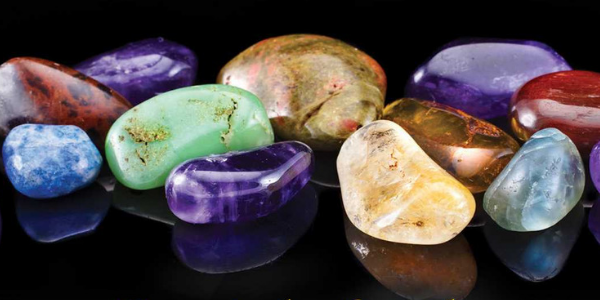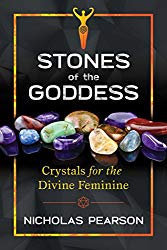
Stones of the Goddess: Crystals for the Divine Feminine, by Nicholas Pearson
Destiny Books, 9781620557648, 470 pp., 2019
Stones of the Goddess: Crystals for the Divine Feminine is a well laid out, easy to use reference book by Nicholas Pearson. Inspired in part by a desire to explore “the connections between the Divine Feminine and the mineral kingdom,” this book allows the reader to engage with crystals, a ubiquitous, and perhaps cliché aspect of modern witchcraft, in a new and modern way.1 This synthesis of scientific thought and metaphysical understanding is uncommon in crystal reference texts, and allows for a deeper engagement with the topic without sacrificing either aspect.
The text is well laid out, covering a straight-forward range of topics divided into three overarching areas: “Crystal Basics,” “Meeting the Goddess,” and “Crystals for the Divine Feminine.” “Crystal Basics” covers crystal energy and provides general introductory information, such as terminology and functions. “Your Crystal Toolbox” includes choosing, cleansing, dedicating and programing crystals and a brief discussion of that most Instagrammable of crystal use: crystal grids. “Meeting the Goddess” is akin to a crash course in Wiccan thought, without actually using the term. This includes “The Goddess in Herstory” section, which primarily relies on shaky references from Marija Gimbutas, an archeologist long thought of as interpreting data through a rosy lens of wishful thinking.
“Facets of the Goddess” includes a discussion of the common Maiden, Mother, and Crone trinity, along with a few common archetypes. A brief discussion of goddess symbolism is included, and while not particularly necessary, it may be of use when creating rituals or crystal grids. The Triple Goddess of Stone is the first indication of some new interpretations of the Goddess, discussing the links between the Earth as a physical measurable object and the Earth as the body of the goddess. While engaging, this discussion does not clearly define the discrete differences between the Maiden, Mother and Crone as seen in igneous, metamorphic and sedimentary rock. The final chapter of this section, “Crystal Spells and Rituals,” again offers a reasonable overview of Wiccan elements of ritual, including the creation of altars and sacred spaces, and covers examples of incorporating crystal use in ritual and spellcasting, such as in charm bags, elixirs, and grids.
The discussion of engaging with deity through binary gendered thinking, “[b]ecause humankind experiences itself through the lens of gender, it is easier to relate to divinity in the same manner”2, is not only woefully essentialist, but also completely out of step for a book published in 2019. Deity “in its primal state is neither masculine nor feminine,”3 the text allows, but is also, the author continues, “undefinable, ineffable, nearly unknowable…[and] hard to relate to.”4 When introducing the Threefold Goddess,5 the author briefly discusses the metaphorical applications of the goddess trinity, it does not fully engage with where current social and political thought is at this current point in time, and could easily have been written 20 years ago. A pacifying passage does not assist the potentially alienating near-constant discussion of goddess wombs and feminine nurturing. If the goddess can be inherent in all things and the very Earth we walk upon, why do we need to assign her human biology?
“Crystals for the Divine Feminine,” the last section of the book, is the text’s true strength. Divided into “Compendium of Crystals,” the largest section of the book, and an appendix that covers a sizable amount of pages of correspondences, the depth and breadth of knowledge covered is invaluable. By incorporating both scientific understanding of how and why crystals develop, along with a strong understanding of personal and popular correspondences, this text moves beyond typical crystal reference books. Each crystal is discussed in detail, and includes correspondences for magical use, elemental and astrological signatures, goddess archetypes and the formation process, along with a sizable paragraphs of general information. Throughout the text, full colour, aesthetic yet informative images are featured, demonstrating the variety of crystals covered, and the forms they may be found in.
Stones of the Goddess is a fantastic reference book, and could be found in the library of any crystal enthusiast or new convert. Thick, weighty and well laminated, the text is not one to keep in a bag for frequent flipping through, but instead to be kept handily on a convenient shelf for regular use. Sustainability in the acquisition and use of magical tools could be a relevant inclusion in the text, given the current boom of crystals as lifestyle accessories, as could a more contemporary understanding of gender diversity. As presented, however, the text is informative, extensive and useful.








